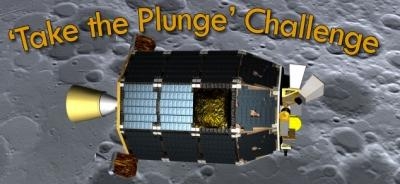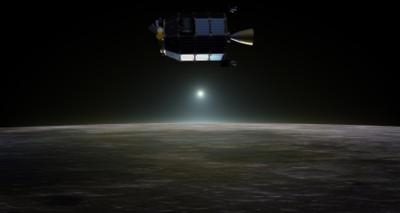Guess The Moment Of Impact And Win A Personalized Certificate From NASA
NASA's Lunar Atmosphere and Dust Environment Explorer (LADEE) spacecraft is gradually lowering its orbital altitude over the moon. LADEE will continue to make important science observations before its planned impact into the lunar surface later this month.

When will it impact the lunar surface? NASA wants to hear your best guess!
LADEE mission managers expect the spacecraft will impact the moon’s surface on or before April 21. On April 11, ground controllers at NASA's Ames Research Center in Moffett Field, CA, will command LADEE to perform its final orbital maintenance maneuver prior to a total lunar eclipse on April 15, when Earth’s shadow passes over the moon. This eclipse, which will last approximately four hours, exposes the spacecraft to conditions just on the edge of what it was designed to survive.
This final maneuver will ensure that LADEE's trajectory will impact the far side of the moon, which is not in view of Earth and away from any previous lunar mission landings. There are no plans to target a particular impact location on the lunar surface, and the exact date and time depends on several factors.
"The moon's gravity field is so lumpy, and the terrain is so highly variable with crater ridges and valleys that frequent maneuvers are required or the LADEE spacecraft will impact the moon’s surface," said Butler Hine, LADEE project manager at Ames. "Even if we perform all maneuvers perfectly, there's still a chance LADEE could impact the moon sometime before April 21, which is when we expect LADEE's orbit to naturally decay after using all the fuel onboard."
Anyone is eligible to enter the "Take the Plunge: LADEE Impact Challenge." Winners will be announced after impact and will be e-mailed a commemorative, personalized certificate from the LADEE program. “We want to thank all those that watched LADEE launch and have followed the mission these past months,” said Jim Green, NASA’s Director for Planetary Science at NASA Headquarters in Washington. “Our Moon holds a special place in so many cultures, and because of LADEE, we’ll know more than ever before about our nearest neighbor.”
LADEE's mission marked several firsts. It was the first demonstration of Optical Laser Communications from space (sent data six times faster than radio), and the first deep space spacecraft designed and built "in house" at NASA’s Ames Research Center. It was also the first payload to launch on a U.S. Air Force Minotaur V rocket integrated by Orbital Sciences Corp., Va., and was the first deep space mission to launch from NASA's Goddard Space Flight Center's Wallops Flight Facility on Wallops Island, Va., when millions watched the night launch on Sept. 6, 2013.

The vending-machine size spacecraft has been orbiting the moon since Oct. 6. On Nov. 10, LADEE began gathering science data, and on Nov. 20, the spacecraft entered its science orbit around the moon's equator. LADEE has been in extended mission operations following a highly successful 100-day prime science phase.
LADEE's three science payload instruments have been working to unravel the mysteries of the lunar atmosphere and dust environment acquiring to date more than 700,000 measurements. In its previous orbit, LADEE's closest approach to the moon’s surface was between 20 and 50 km, and its farthest point was between 75 and 150 km – a unique position that allows the spacecraft to frequently pass from lunar day to lunar night, approximately every two hours. This vantage provides data about the full scope of changes and processes occurring within the moon's tenuous atmosphere.
Scientists hope to address a long-standing question: Was lunar dust, electrically charged by sunlight, responsible for the pre-sunrise glow detected during several Apollo missions above the lunar horizon? LADEE also is gathering detailed information about the structure and composition of the thin lunar atmosphere.
A thorough understanding of these characteristics of our nearest celestial neighbor will help researchers understand other bodies in the solar system, such as large asteroids, Mercury, and the moons of outer planets.
(Images provided by NASA)
 ANN's Daily Aero-Term (05.01.24): Say Altitude
ANN's Daily Aero-Term (05.01.24): Say Altitude ANN's Daily Aero-Linx (05.01.24)
ANN's Daily Aero-Linx (05.01.24) Classic Aero-TV: Korean War Hero Twice Reborn
Classic Aero-TV: Korean War Hero Twice Reborn Airborne 04.29.24: EAA B-25 Rides, Textron 2024, G700 Deliveries
Airborne 04.29.24: EAA B-25 Rides, Textron 2024, G700 Deliveries Airborne Affordable Flyers 05.02.24: Bobby Bailey, SPRG Report Cards, Skydive!
Airborne Affordable Flyers 05.02.24: Bobby Bailey, SPRG Report Cards, Skydive!




